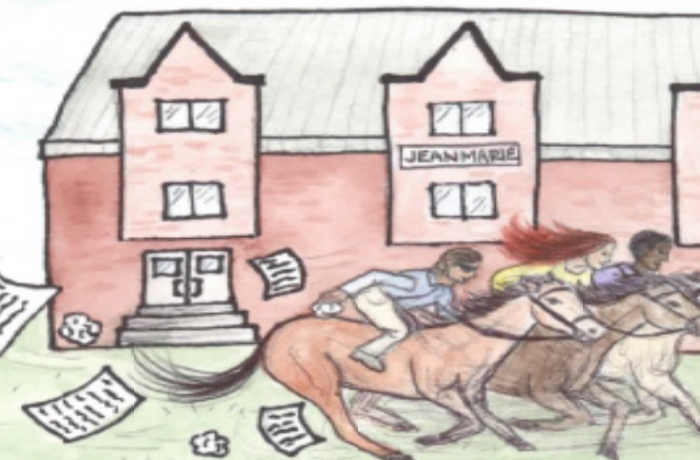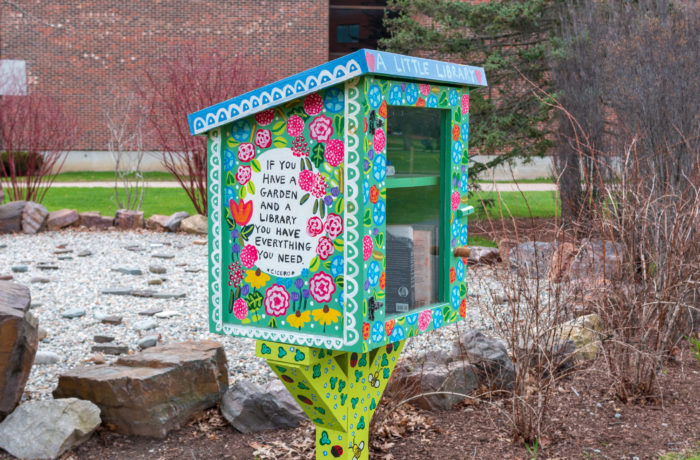By Audrey Sinclair
Down a hospital-like corridor with one gurney of breakfast trays, another of morning medications, and a scattering of patients with walkers and wheelchairs, two unlikely visitors trot and sniff, weaving themselves through the busy operation. While patients have their vitals taken and anxiously await the next step of their rehabilitation, these two visitors work their magic as they undergo a different kind of evaluation.
At Starr Farm Nursing Center in Colchester, Tank, a lumbering golden Pyrenees mix and Cabot, a black Labrador Retriever go from room to room, offering sniffing, tail-wagging greetings to everyone they met, while their handlers focused on ensuring the dogs’ and the residents’ safety. Wheelchairs, IV lines, and open medication bottles can mean serious safety issues but when dog meets human, all of the training and watchful eyes pay off.
Nursing homes, hospitals, and prisons all tend to bring about feelings of discomfort, solitude, and sometimes hopelessness, making it easy to fall into bleak life patterns. The therapy dog movement has grown in response to these challenges, in the belief that a simple visit by man’s best friend can transpire transformations and alter attitudes.
Therapy dogs are certified dogs that visit and interact with people in need. When paired with a trained handler, the dog and human team could make someone feel better after a bad experience, lower stress levels, and make a person feel happy and loved.
Benefits of therapy dogs have been documented around the world throughout modern history. Following the tragic Sandy Hook shooting in 2012, several therapy dogs visited the elementary school to comfort survivors. The children said the dogs served as a distraction from their grief and made them feel happy, a significant feat following the massacre.
An abundance of dog lovers are convinced that their pooch, too, could work wonders as a therapy animal. But regardless of their owners’ belief in their curative effects, just what does it take to become a therapy animal?
In order to become a certified therapy dog, the evaluation goes beyond the dog itself. Most organizations require that both the dog and its guide pass an evaluation based on personality, actions, and awareness before the team is certified in a uniform and a badge.
Therapy Dogs of Vermont (TDV) a nonprofit, volunteer-run organization that certifies dogs and their handlers and hosts testing sessions. One recent session in Williston involved two pairs of aspiring therapy dog handlers and seven dogs to be tested.
“Not every dog is meant for this sort of work,” said a TDV volunteer who led the day’s testing session. In order to meet the standards of the organization, each dog and handler pair need to pass a testing session and three practical evaluations to work with TDV.
The six-part examination is designed to test how a dog and handler will act in common situations within this field of work. Each of the six parts, namely, The Stranger, Obedience Plus, Weaving, Distractions, Body Handling, and Crowded Elevator Simulation, evaluates how each dog reacts to people with strange, new behaviors, as well as unfamiliar situations and distracting noises that may create aggression or fear.
“We look out for any body language that could say the dog is uncomfortable. The [dog’s] face is usually the indicator that something bad is about to happen, ”said Deb Helfrich, director of training. Potentially dangerous body language could include tense facial features like pulled back ears. By the end of the two and a half hour session, the seven dogs in attendance were laying on the floor in exhaustion, heads resting on the ground.
If the staff decide a dog would be safe and therapeutic, the TDV teams then visit a nursing home with an evaluator for a practical test. At these evaluations, the observer can see if that dog has a positive effect on most people.
Christine and Ben Gilliam, a preschool teacher and stay-at-home business consultant, brought their dog, Tank, a yellow Lab and Great Pyrenees mix, to Starr Farm Nursing Center in Colchester to complete their third evaluation.
The Gilliams joined Craig Deslaurier, TDV’s assistant developer of hub development and growth, as well as Jason Reed, an evaluator and certified volunteer for the organization. Deslaurier brought his own therapy dog, Cabot, a gentle black lab who loves to lick kisses onto everyone she sees.
Cabot approached a man in a wheelchair who, when he felt a lick on the hand from the lab, smiled widely. Tank visited a family whose son was a resident in the nursing home. The boy’s enthusiasm changed his voice from quiet to loudly excited, and his parents’ expressions and bodies softened from tense to comfortable. One woman, wheelchair bound and deaf, was a dog owner when younger and despite her difficulties communicating, showed a softened expression when her hand met the top of a velvety mop of fur.
As Deslaurier thinks back on his years of working with TDV, he recalls witnessing the benefits of therapy dogs countless times. Wherever he and Cabot go, he is sure to provoke at least one positive response. One time, Deslaurier visited his old work supervisor in a hospital following a medical emergency. The man was so moved with inspiration and hope, he told Deslaurier, “I’m going to get better so I can come take care of your dog when you need.”
In another inspiring encounter, Deslaurier and his dog visited a man, blind and deaf, in a nursing home. It took some time to direct his hand to the dog’s body, but when he realized what he was encountering, “his face went from unexpressive to smiling,” Deslaurier recalls. “He didn’t say anything, but you knew there was an emotional connection.”
Therapy Dogs of Vermont visits people in Vermont, New Hampshire, and Canada, which creates a demand that they can barely keep up with. “We’re always expanding,” said Deslaurier. Their most recent evaluation session concluded with three dogs who passed on and four who showed some concerning behaviors.The number of people looking to be volunteers for their organization keeps growing every year and Deslaurier looks forward to the future of the organization and hopes to benefit as many


